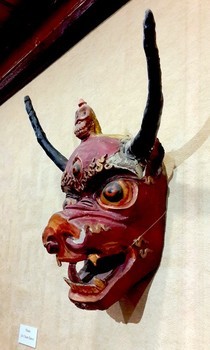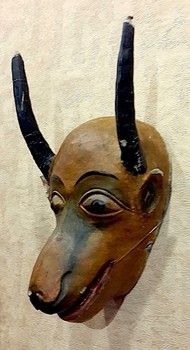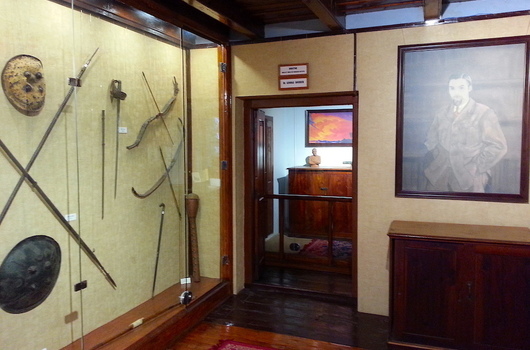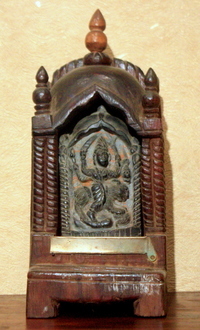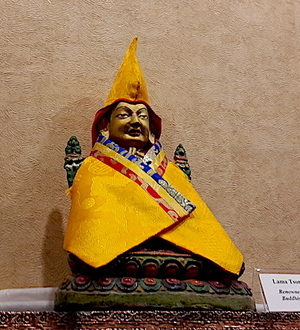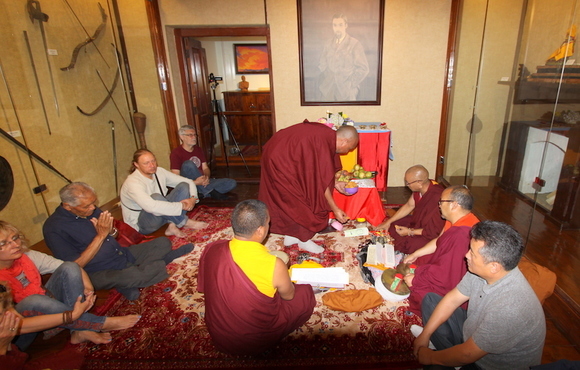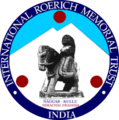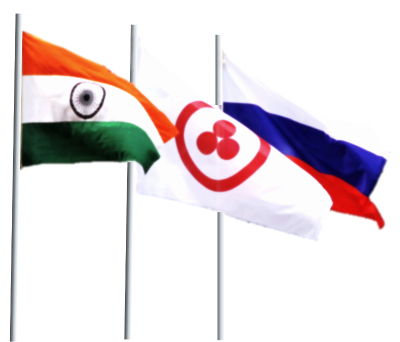A new museum display “Memorial Study of George Roerich — the Director of the Urusvati Himalayan Research Institute” was opened in IRMT on 9th October 2016 during the October Festival days in the Roerichs’ Estate.
The exhibition was created in a former study of George (Yuri) Roerich that is placed on the 2nd floor of the Administrative building of the Institute. Exactly in this place The Urusvati Institute was started. Here the Roerichs at the beginning of the 1930-s opened the Department of Archaeology, the Department of Natural Sciences and Medicine, Research Library and Museum for displaying expedition finds.
One of the centerpieces of the George Roerich’s Study is a big desk that was used by the scientist in 30-s — 40-s of XX century. Visitors can see the Remington Portable, an ancient memorial typewriter, a wooden set for paper and stationary, lexicographical cards with notes done by clear small handwriting of George Roerich.
By the time of arriving to Kullu Valley George, the elder son of Nicholas and Helena Roerich was 26 years old.
Central-Asian expedition where he had been fully committed was behind him. Knowledge of eastern languages including Sanskrit and alive dialects of India and Tibet let the young scientist to communicate with local people easily. He recorded ancient legends and studied old manuscripts; improved existing maps and worked at archaeological excavations; was responsible for negotiations with guides and for the expedition security.
Despite of young age he had all-round knowledge in history, archeology, literature, ethnography, religion, culturology — and it allowed the young scientist to become the director of the Urusvati Himalayan Research Institute.
His multi knowledge helped him to lead and coordinate the team work in all fields of scientific research. Under his leadership the Institute soon became one of the scientific flagships of India. The Institute cooperated with many science organizations of Asia, Europe and America, interchanged issues with 285 universities, museums, institutes, libraries. The Urusvati annual Journal displayed various scientific activities of the Institute. Famous scientists are in the list of scientific counsellors, corresponding member, regular employees of the Institute such as Albert Einstein, Robert Millikan, L. de Broglie, Sven Hedin, Serge Metalnikov, С.С. Lozinа, J.C.Bose.
George Roerich attentively monitored new books publications and maintained permanent contacts with publishers of the USA, England, Germany, France. A numerous library was created in the Institute and ancient manuscripts formed the considerable part of it. A special cabinet with deep storages for keeping manuscripts is exposed in the George Roerich’s Study.
Here you can see also card drawers for card-index keeping. There are some kinds of cards in the collection of the Urusvati Institute created by George Roerich in the process of the science work. The biggest part of it is lexicographical cards with letters, words and phrases written down in Tibetan language and cards with comparative lexical data from other languages. That data was used by the scientist for Tibetan-Russian-English dictionary making with Sanskrit parallels. He continued the work on it for all his life. The dictionary in 10 volumes was published only after George Roerich's death.
Cards named “Lahul” are the special group of the Tibetan cards, they formed the basis for The Tibetan Dialect of Lahul. One more card-index of George Roerich is relating to the work on the History of Central Asia. This major work was created by the scientist in Kullu in 1935-1939. The cards include notes of George Roerich in Russian language with information about historical events of peoples in the Central Asia.
There is a tubus for keeping and transporting maps in the George Roerich’s Study exposition. To be noted that the cartographic collection of IRMT contains some maps likely made by George Roerich himself. They are a map of Sikkim made during Central Asian expedition and a map of Manchuria expedition with an area of Inner Mongolia where the expedition of the Urusvati Institute was in 1935.
George Roerich was a member of the most expeditions of the Urusvati Institute. Some things from his field equipment can be seen in the Study display. They are leather briefcase for documents and papers with long belt, round case with removable cover for the field equipment and also two-fold cantle bag. It is known that George Roerich was an excellent horse rider and a considerable amount of horse riding equipment items have been kept in the IRMT collection.
Activities of the Urusvati Himalayan Research Institute included archeological sphere and connected with its science and art, natural science including ancient and modern medicine and pharmacology, linguistic and folklore. It is hard to understand now how one person had time to manage various activities of the Institute and at the same time to work out the most difficult issues of linguistic and philology.
For the outstanding service in the fields of languages study, literature, history, ethnography, archeology of Central and South Asia George Roerich was elected member of the Royal Asiatic Society in London, the Asiatic Society of Bengal, the Paris Geographic Society, American Archeological and Ethnographic Societies and many other science organizations of the world.
George Roerich consistently realized a principal of matching contemporary scientific evidences of the West and ancient spiritual knowledge of the East put into a foundation of the Urusvati Institute by the Roerichs. George Roerich deeply knew life and history of Asia, clearly understood their people nature and their spiritual traditions. He made a study of that spiritual knowledge inviting for cooperation Tibetan and Indian lamas and scholars such as Professors Ram Rahul, Suniti Kumar Chatterji, A.L.Altekar, pandit Rahul Sankrityayan, lamas Gendun Chophel, Lobsang Mingyur Dorje and many others.
Truly worldwide fame was brought to George Roerich with translation of the Blue Annals, a unique historical artifact. The work on it started in Kullu and it was published in 1940-1953 in Calcutta — and two volumes of the issue are presented in the glass case near George Roerich’s Study.
George Roerich put special emphasis to study the heroic epic about King Kesar or Gesar — a legend hero of Asia, whose image is connected with key milestones of people’s memory in wide areas of Tibet, Ladakh and Mongolia. The name of Gesar invisibly united nomads’ hearts giving them courage and lightful aspirations. It was no coincidence that Nicholas Roerich devoted his painting “Gesar Khan” (1941) to his elder son.
The painting reproduction can be seen in the display of George Roerich’s Study. It was presented to IRMT by the International Centre of the Roerichs (Moscow) as well as a small sculptural portrait of George Roerich (the author is Alexey Leonov). The sculpture succeeded in delivering the scientist’s resoluteness, willpower, readiness and at the same time — his kind starry glance. Many people who knew George Roerich personally mentioned his unforgettable inner light.
Visitors can see an interesting exhibition in the hall in front of the memorial Study of George Roerich. This renewed hall was opened in spring of 2017. Here are presented valuable ethnographic collections, gathered by the Roerichs and the team during the expeditions and that were displayed here in the Administrative building in the Museum of the Urusvati Institute in 1930-s.
The display of old weapons attracts the visitors’ attention. Knowing George Roerich’s interest to military science it is fair to assume that it was him who built the major part of the Institute’s weapons collection including such items as Tibetan long sword, Tibetan double-edged javelins, shields made of rhinoceros’ leather, arched cutlasses, a bow and bamboo quiver for arrows. Along with Eastern weapons an old English gun and a sword are exhibited here as long as a walking stick with hidden spike and an elephant head shape handle presented to the Roerichs by a maharaja of the Kingdom of Mysore.
In exhibition of another glass case you can see some masks for the Tsam Mistery made of paper-mache. Tsam is a dancing pantomime with religious-philosophical content. It is performed annually in Buddhism monasteries of Tibet and Mongolia. The monks in clothes and masks of Buddhism pantheon characters demonstrated a victory of Buddhism Study over bad spirits, life over death, good over evil. Masks for Tsam were usually made of paper-mache or wood and consecrated before the using. The process of their creating was always considered as high art and the masks were regarded as holy relics.
A miniature temple of Goddess Durga presented at the exhibition can be also called a holy relic. An image of Hindu Goddess is carved in a small stone and put in a wooden frame in the form of a temple with carved columns and covers.
Samples of fine wood carvings most likely used as ornaments can be seen on the mantelshelf. Here you can see also Tibetan copper ritual vessels and a sculpture of Lama Tsong-kha-pa, a Buddhist Teacher and Holy Man, made in one of Buddhist monasteries.
There is a collection of items from China in this glass case: beautiful glasses with images of dragons, cups and vases with floral ornament in blue and azure tones. All of them are made of metal in Chinese enamel. It can be supposed that the collection was brought here from China by Nicholas and George Roerich at the end of expedition to Manchuria.
Opening of the George Roerich’s Study display in the room that used to be abandoned for many years has signaled the beginning of the large-scale joint effort by the Russian and Indian experts to develop several permanent exhibitions on the history and activities of the Urusvati Himalayan Research Institute in the former Administrative Building of the Institute.

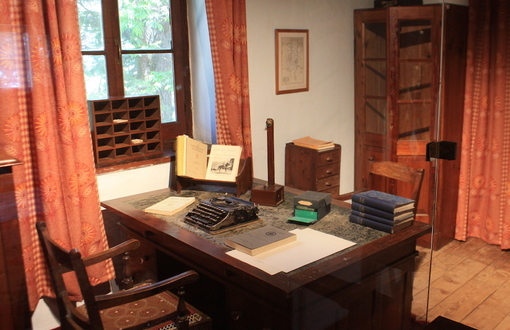
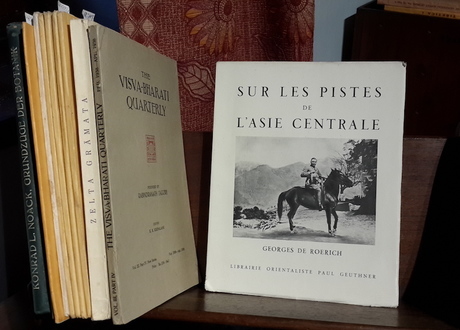


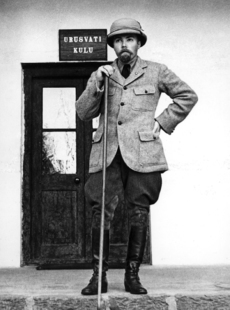
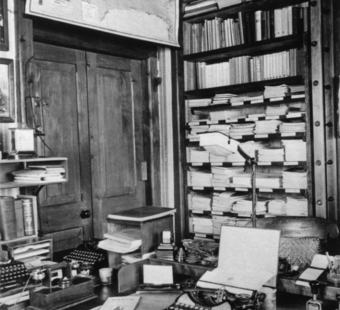
There is also a desk shelf with some books from the Urusvati Institute library collection. Some works of George Roerich are among them: The Tibetan Dialect of Lahul of the Tibetica series in English language and the Trails to Inner Asia in French language; the third volume of the Journal of Urusvati Himalayan Research Institute; the Prabuddha Bharata, the Indian Culture magazines and other issues.


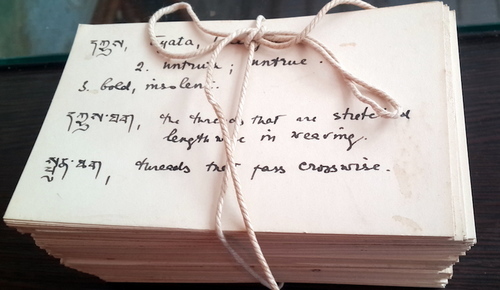
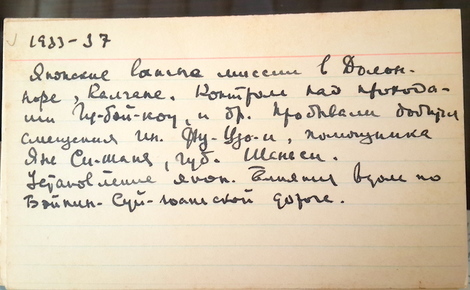
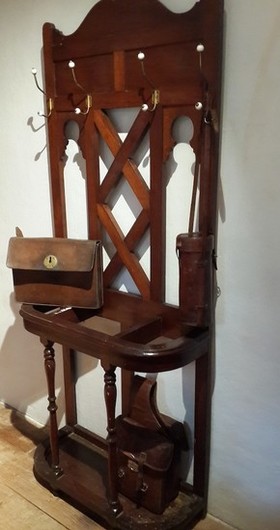
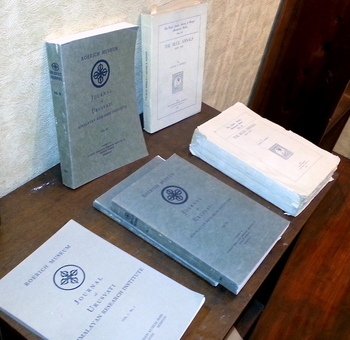

One chapter of these ancient Tibetan annals is dedicated to Kalachakra — a Great Teaching of Shambhala. This is a complicated system of knowledge about macrocosm that says a life of a human being is connected with the whole Universe. All of the literature about Kalachakra is written in symbolic language known only by devoted people. George Roerich’s translation is acknowledged as one of the best by all Buddhist specialists.
